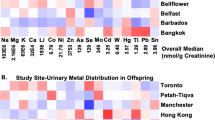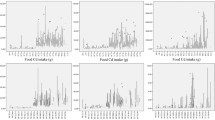Abstract
Background and objectives
Cd absorption may be enhanced in association with iron (Fe) deficiency. Women have increased risks of Fe loss at the time of child birth as well as breast-feeding of children. Possible effects of these two factors were investigated in the present study.
Methods
Data were drawn from previous publications from this group on Cd and tubular dysfunction markers (i.e., α1-microglobulin, β2-microglobulin, and N-acetyl-β-d-glucosaminidase) in urine of adult women in non-polluted areas in Japan. Information including age, smoking, number of children, and types of child feeding was obtained by self-administered questionnaires at the time of urine sampling. In practice, 17,468 cases were available, from which 12,869 cases were employed in the present analyses after exclusion of smokers, former or current patients of anemia or hypertension, and those with incomplete answers. Lactation burden was scored after coding of breast, mixed, and bottle feeding with 2, 1, and 0 for each child followed by summation for all children born to a mother. In order to exclude possible effect of aging, women were stratified by 5 years of age to randomly select equal numbers of cases and controls, followed by summation for all ages for comparison.
Results
The arithmetic mean age and the geometric mean Cd (as observed) were 49.7 years and 1.13 μg/l urine. The number of children was 0–7, and lactation burden score ranged from 0–12. Multiple regression analyses were conducted with age and either number of children or lactation burden scores as independent variables and Cd as a dependent variable. The results showed that age was an influential variable. Comparison after matching for age showed that having 1, 2, or 3 children or lactation burden score up to 2 were associated with a significant increase in Cd. Lactation burden score up to 2 was also associated with increased Cd in urine and such trend persisted up to the highest score of 5–12. The results of trend tests were generally in agreement with these observations. Further comparison after age-matching showed that women having 2 or 3 children but no lactation burden had higher Cd than those with no children. In contrast, Cd was not higher for those having 2 or 3 children with substantial lactation scores (i.e., 2–4 or 3–6) than for those with the same number of children without lactation burden.
Conclusions
Giving birth to 1–3 children was associated with an increase in urinary Cd, suggesting that child birth might be associated with elevation in Cd body burden. The effect of lactation is probably attributable to that of number of children. Further studies are necessary to examine whether the association is also observable in mothers who have 3 or more children.

Similar content being viewed by others
References
Åkesson A, Berglund M, Schütz A, Bjellerup P, Bremme K, Vahter M (2002) Cadmium exposure in pregnancy and lactation in relation to iron status. Am J Public Health 92:284–287
Berglund M, Akesson A, Nermell B, Vahter M (1994) Intestinal absorption of dietary cadmium in women depends on body iron stores and fiber intake. Environ Health Perspect 102:1058–1066
Ezaki T, Tsukahara T, Moriguchi J, Furuki K, Fukui Y, Ukai H, Okamoto S, Sakurai H, Honda S, Ikeda M (2003a) No clear-cut evidence for cadmium-induced tubular dysfunction among over 10,000 women in the Japanese general population; a nationwide large-scale survey. Int Arch Occup Environ Health 76:186–196
Ezaki T, Tsukahara T, Moriguchi J, Furuki K, Fukui Y, Ukai H, Okamoto S, Sakurai H, Honda S, Ikeda M (2003b) Analysis for threshold levels of cadmium in urine that induce tubular dysfunction among women in non-polluted areas in Japan. Int Arch Occup Environ Health 76:197–204
Gallagher CM, Chen JJ, Kovach JS (2011) The relationship between body iron stores and blood and urine cadmium concentrations in US never-smoking, non-pregnant women aged 20–49 years. Environ Res 111:702–707
Gensler H (1997) Welfare and the family size decision of low-income, two parent families. Appl Econ Lett 4:607–610
Hamada H (1990) Treatment of pregnancy with complications: anemia. Acta Obstet Gynaecol Jpn 42:193–196 (in Japanese)
Hokama T, Odo S (1992) Iron concentration in human milk in Naha city. Child Health Res 31:462–465 (in Japanese)
Ikeda M, Moriguchi J, Ezaki T, Fukui Y, Ukai H, Okamoto S, Shimbo S, Sakurai H (2005) Smoking-induced increase in urinary cadmium levels among Japanese women. Int Arch Occup Environ Health 78:533–540
Ikeda M, Ezaki T, Moriguchi J, Fukui Y, Okamoto S, Ukai H, Sakurai H (2006) No meaningful increase in urinary tubular dysfunction markers in a population with 3 μg cadmium/g creatinine in urine. Biol Trace Elem Res 113:35–44
Ikeda M, Ohashi F, Moriguchi J, Sakuragi S (2010) Low cadmium levels in urine of residents in two prefectures where cadmium levels in locally-harvested brown rice are higher than in other prefectures in Japan. Biol Trace Elem Res 139:217–227
Ikeda M, Moriguchi J, Sakuragi S, Ohashi F (2012a) Association of past diseases with levels of cadmium and tubular dysfunction markers in urine of adult women in non-polluted areas in Japan. Int Arch Occup Environ Health. doi:10.1007/s00420-012-0757-5
Ikeda M, Moriguchi J, Sakuragi S, Ohashi F (2012b) Bi-linear dose-response relationship in general populations with low-level cadmium exposures in non-polluted areas in Japan. Int Arch Occup Environ Health. doi:10.1007/s00420-011-0691-y
International Programme on Chemical Safety (1992) Environmental Health Criteria 134. Cadmium, World Health Organization, Geneva, pp 55–65
Jackson S (1966) Creatinine in urine as an index of urinary excretion rate. Health Phys 12:341–350
Kim E-S (2000) Lactation and intake of breast milk by infants. In: Maternal Health Study Group (ed) Pregnancy, Lactation and Infant’s Health. Kyomunsa Publishers, Seoul, pp 27–40 (in Korean with English translation)
Kippler M, Ekström E-C, Lönnerdal B, Goessler W, Akesson A, Arifeen SE, Persson L-Å, Vahter M (2007) Influence of iron and zinc status on cadmium accumulation in Bangladeshi women. Toxicol Appl Pharmacol 222:221–226
Lauwerys RR, Hoet P (2001) Cadmium. In: Industrial chemical exposure: guidelines for biological monitoring, 3rd edn. Lewis Publishers, Boca Raton, p 54
Maeda T, Sugihara C, Tanaka T, Funakawa K, Nose T, Itoh T (1989) Hemoglobin concentration, hematocrit and serum iron levels of mothers and iron in breast milk. Mater Health 30:299–305 (in Japanese)
Meltzer HM, Brantsæter AL, Borch-Iohnsen B, Ellingsen DG, Alexander J, Thormassen Y, Stigum H, Ydersbond TA (2010) Low iron stores are related to higher blood concentrations of manganese, cobalt and cadmium in non-smoking, Norwegian women in the HUNT 2 study. Environ Res 110:497–504
Ministry of Health Labour and Welfare, Japan (2005) Dietary reference intakes for Japanese: iron. Dai-ichi Shuppan Press, Tokyo, pp 161–171 (in Japanese)
Ministry of Health Labour and Welfare, Japan (2009) Vital statistics of Japan, vol 1. Health and Welfare Statistics Association, Tokyo, pp 94–95 (in Japanese with English translation)
Ministry of Health Labour and Welfare, Japan (2011) The national health and nutrition survey in Japan, 2008. Dai-ichi Shuppan Press, Tokyo, pp 92–93 (in Japanese)
Moriguchi J, Ezaki T, Tsukahara T, Fukui Y, Ukai H, Okamoto S, Shimbo S, Sakurai H, Ikeda M (2005a) Effects of aging on cadmium and tubular dysfunction markers in urine from adult women in non-polluted areas. Int Arch Occup Environ Health 78:446–451
Moriguchi J, Ezaki T, Tsukahara T, Fukui Y, Ukai H, Okamoto S, Shimbo S, Sakurai H, Ikeda M (2005b) Decrease in urine specific gravity and urinary creatinine in elderly women. Int Arch Occup Environ Health 78:438–445
Moriguchi J, Ezaki T, Tsukahara T, Furuki K, Fukui Y, Okamoto S, Ukai H, Sakurai H, Ikeda M (2005c) α1-Microglobulin levels and correlation with cadmium and other metals in urine of non-smoking women among general population in Japan. Toxicol Environ Chem 87:119–133
Moriguchi J, Inoue Y, Kamiyama S, Sakuragi S, Horiguchi M, Murata K, Fukui Y, Ohashi F, Ikeda M (2010) Cadmium and tubular dysfunction marker levels in urine of residents in non-polluted areas with natural abundance of cadmium in Japan. Int Arch Occup Environ Health 83:455–466
Rainsford SG, Lloyd Davies TA (1965) Urinary excretion of phenol by men exposed to benzene; a screening test. Br J Ind Med 22:21–26
Terao T (2004) Atonic bleeding. In: Yajima S, Nakano M, Taketani Y (eds) Gynecology and obstetrics, 2nd revised version. Nankodo Publishers, Tokyo, pp 301–302 (in Japanese)
Tsukahara T, Ezaki T, Moriguchi J, Furuki K, Fukui Y, Ukai H, Okamoto S, Sakurai H, Ikeda M (2003) No significant effect of iron deficiency on cadmium body burden or kidney dysfunction among women in the general population in Japan. Int Arch Occup Environ Health 76:275–281
Vahter M, Berglund M, Akesson A, Liden C (2002) Metals and women’s health. Environ Res 88:145–155
Watanabe T, Koizumi A, Fujita H, Kumai M, Ikeda M (1983) Cadmium levels in the blood of inhabitants in nonpolluted areas in Japan with special references to aging and smoking. Environ Res 31:472–483
Watanabe T, Iwami O, Shimbo S, Ikeda M (1993) Reduction in cadmium in blood and dietary intake among general populations in Japan. Int Arch Occup Environ Health 65:S205–S208
Yamagami T, Ezaki T, Moriguchi J, Fukui Y, Okamoto S, Ukai H, Sakurai H, Aoshima K, Ikeda M (2006) Low-level cadmium exposure in Toyama City and its surroundings in Toyama prefecture, Japan, with references to possible contribution of shellfish intake to increase urinary cadmium levels. Sci Total Environ 362:56–67
Acknowledgments
Thanks are due to the administration and staff of Kyoto Industrial Health Association, Kyoto, Japan, for their interest in and support to this study.
Conflict of interest
The authors declare that they have no conflicts of interest.
Author information
Authors and Affiliations
Corresponding author
Rights and permissions
About this article
Cite this article
Ikeda, M., Moriguchi, J., Sakuragi, S. et al. Relation of child birth and breast-feeding burden with cadmium and tubular dysfunction marker levels in urine of adult women in non-polluted areas in Japan. Int Arch Occup Environ Health 86, 689–698 (2013). https://doi.org/10.1007/s00420-012-0800-6
Received:
Accepted:
Published:
Issue Date:
DOI: https://doi.org/10.1007/s00420-012-0800-6




